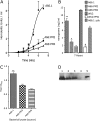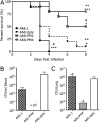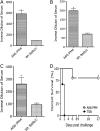Designed reduction of Streptococcus pneumoniae pathogenicity via synthetic changes in virulence factor codon-pair bias
- PMID: 21343143
- PMCID: PMC3069727
- DOI: 10.1093/infdis/jir010
Designed reduction of Streptococcus pneumoniae pathogenicity via synthetic changes in virulence factor codon-pair bias
Abstract
In this study, we used a previously described method of controlling gene expression with computer-based gene design and de novo DNA synthesis to attenuate the virulence of Streptococcus pneumoniae. We produced 2 S. pneumoniae serotype 3 (SP3) strains in which the pneumolysin gene (ply) was recoded with underrepresented codon pairs while retaining its amino acid sequence and determined their ply expression and pneumolysin production in vitro and their virulence in a mouse pulmonary infection model. Expression of ply and production of pneumolysin of the recoded SP3 strains were decreased, and the recoded SP3 strains were less virulent in mice than the wild-type SP3 strain or a Δply SP3 strain. Further studies showed that the least virulent recoded strain induced a markedly reduced inflammatory response in the lungs compared with the wild-type or Δply strain. These findings suggest that reducing pneumococcal virulence gene expression by altering codon-pair bias could hold promise for rational design of live-attenuated pneumococcal vaccines.
Figures






References
-
- Ikemura T. Codon usage and tRNA content in unicellular and multicellular organisms. Mol Biol Evol. 1985;2:13–34. - PubMed
Publication types
MeSH terms
Substances
Grants and funding
LinkOut - more resources
Full Text Sources
Other Literature Sources

